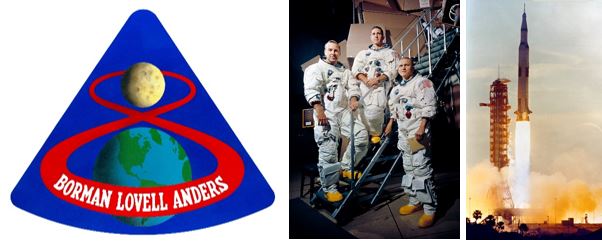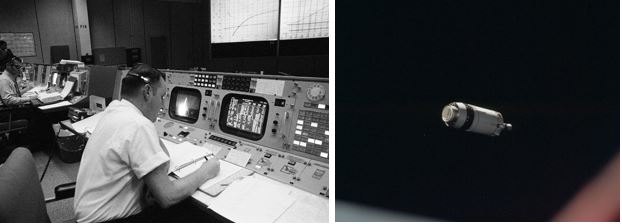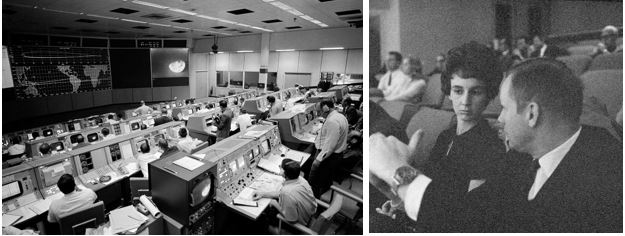In the early morning of Dec. 21, 1968, at Kennedy Space Center’s (KSC) Launch Pad 39A, the five engines of the Saturn V’s first stage came to life precisely on time at 7:51 AM EST, powering up to their full 7.5 million pounds of thrust. The brilliance of the flame was like a second sunrise. At the top of the 6.5-million pound rocket, Apollo 8 astronauts Frank Borman, James A. Lovell, and William A. Anders were strapped inside their Command Module (CM), the first humans to first-hand experience a Saturn V launch. After 2.5 minutes, the first stage had exhausted its fuel, burning it at the rate of 13 tons every second, and had carried the vehicle to an altitude of 40 miles. The second stage took over, burning for more than six minutes before it too fell away. The third stage, called the S-IVB, finished placing Apollo 8 into Earth orbit 11 and a half minutes after liftoff.
As soon as the rocket had cleared the launch tower, control of the mission transferred from the Launch Control Center at Launch Complex 39 to Mission Control at the Manned Spacecraft Center, now the Johnson Space Center in Houston. Three teams of controllers, led by Lead Flight Director Clifford E. Charlesworth and Flight Directors Glynn S. Lunney and Milton L. Windler, working in eight-hour shifts, monitored all aspects of the mission until splashdown. The capsule communicator, or Capcom, the astronaut in Mission Control who spoke directly to the crew, during the launch was Michael Collins, who at one time was part of the Apollo 8 crew but was sidelined with a bone spur in his neck and replaced by Lovell less than five months before the flight. Other Capcoms during the mission were Thomas K. Mattingly and Gerald P. Carr.
Once in orbit, the crew spent the next two and a half hours checking out its spacecraft, still attached to the S-IVB third stage, ensuring all was ready for the next phase of the mission. Then came the call from Mission Control that had never been uttered before during a space flight: “Apollo 8, you are Go for TLI.” With those words, TLI meaning Trans Lunar Injection, Capcom Collins committed the mission to break the bonds of Earth’s gravity and set a course for the Moon. Near the end of the second revolution around the Earth, the S-IVB’s engine fired for a second time. This burn lasted more than five minutes and increased Apollo 8’s speed from about 17,400 miles per hour to 24,226 miles per hour, enough to overcome Earth’s gravity and send it on a trajectory toward the Moon. Soon after the burn ended, the astronauts separated their spacecraft from the spent S-IVB and used the Service Module (SM) Reaction Control System (RCS) thrusters to maneuver a short distance away and turn around to inspect and photograph the third stage. On future missions, crews performed a transposition and docking maneuver to remove the Lunar Module (LM) from the S-IVB. But on Apollo 8, the third stage only carried a LM Test Article-B (LTA-B), used to partially simulate the mass of a LM during launch and which remained attached to the stage. A separation burn moved the spacecraft away from the S-IVB, which vented its remaining fuel to send it into solar orbit.
The astronauts now had some time to look out their windows and could visibly see the Earth receding as they sped away from their home planet. They quickly passed the previous human spaceflight altitude record of 850 miles set by Charles “Pete” Conrad and Richard F. Gordon during the Gemini 11 mission in 1966. At the same time, with the Earth’s gravity still exerting influence on the spacecraft, their velocity was gradually decreasing. The Apollo 8 astronauts became the first humans to traverse the Van Allen radiation belts, a region of charged particles trapped by the Earth’s magnetic field first discovered by NASA’s Explorer 1 spacecraft in 1958.
As their next task, the astronauts deployed the spacecraft’s high gain antenna at the base of the SM to maintain good communication with Mission Control at lunar distances. They also put the spacecraft into Passive Thermal Control mode, often referred as barbecue mode, in which it slowly spun on its longitudinal axis to evenly distribute the extreme temperatures encountered in space. The spacecraft completed one rotation on its axis every hour. With these major activities behind them, the astronauts finally changed from the spacesuits in which they launched to more comfortable overalls, which they wore the remainder of the flight. They also ate their first meal of the flight, about nine hours after liftoff.
About two hours later, the crew executed the mission’s first midcourse correction maneuver, using the SM’s Service Propulsion System (SPS) engine to refine their trajectory. This engine, thoroughly tested during Apollo 7 in Earth orbit, was critical for getting the spacecraft into and out of lunar orbit. For this maneuver, the SPS engine fired for 2.4 seconds and slightly increased the vehicle’s speed. This maneuver was so accurate that two additional planned burns before they reached the Moon’s vicinity were not required. Borman then began his first sleep period – for this mission, as with Apollo 7, at least one crewmember remained awake at all times. On later Apollo flights, this practice was abandoned as unworkable. Lovell and Anders began their sleep once Borman was awake again, after a short 5-hour sleep period.
For the next two days, the Apollo 8 astronauts continued their coast to the Moon, a relatively uneventful time marked by periodic navigation checks and spacecraft housekeeping chores. As part of the Public Affairs Office effort to keep the crewmembers up to date on current events, Capcom Collins informed them that the crew of the USS Pueblo, held by North Korea for 11 months, were freed on Dec. 23. Borman replied, “Wonderful!”
At around 31 hours into the mission, the Apollo 8 astronauts began their first TV broadcast when they were nearly 140,000 miles from Earth. They transmitted black and white images of their activities inside the cabin, including Lovell preparing a meal, but attempts to show the home audience views of the Earth through the windows during this broadcast were not successful. This first transmission lasted 23 minutes. A second transmission at 55 hours was more successful, as the crew learned to tape the proper filters to the camera’s telephoto lens, showing TV viewers at home a view of Earth from more than 200,000 miles away. Since the TV image was in black and white, Lovell provided a verbal description of the colors as the crew saw them. In describing the apparent size of the Earth, Lovell said, “It’s about as big as the end of my thumb” held at arm’s length. Minutes after the end of the second broadcast, which lasted about 26 minutes, Apollo 8 and its crew entered the Moon’s sphere of influence, or more accurately where the Moon’s gravitational influence became the dominant force acting on the spacecraft. They were about 200,000 miles from Earth and 35,000 miles from the Moon and had slowed down to 2,225 mph. Their speed started increasing as the Moon started pulling them toward it. Two of the astronauts’ wives, Marylin Lovell and Valerie Anders, visited the Mission Control viewing room during this time.
A second midcourse correction at 61 hours using the RCS thrusters lasted about 12 seconds to slow the spacecraft slightly to lower the closest approach to the Moon’s surface.
At 68 hours 58 minutes into the flight, as Apollo 8 disappeared behind the Moon’s leading edge, contact with the Earth was cutoff. The all-important Lunar Orbit Insertion burn would take place out of communication with Mission Control, and for a few minutes, only Borman, Lovell, and Anders knew whether it had succeeded in placing the first human beings into orbit around the Moon.
































